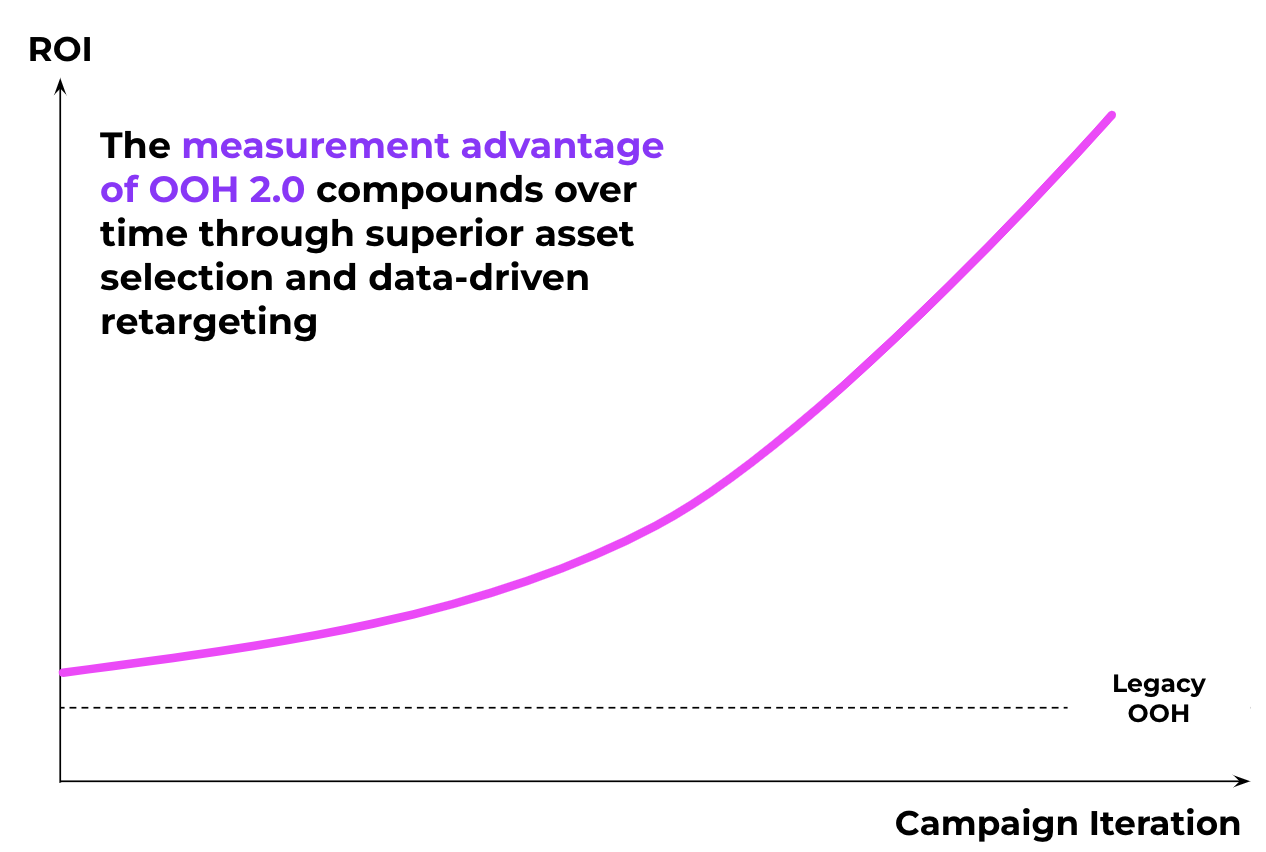Contents
Out-of-home advertising is one of the longest-running mediums for marketers to communicate with their audience. OOH is advertising for a product or service in the physical world through billboards, signage, ads in taxi cabs, and posters. OOH can take shape in both static and digital formats, and digital out-of-home is a growing subset of OOH where messages are displayed on TV or computer screens, leveraging animation and video.
More and more marketers today are finding their old tactics aren't as impactful to reach digitally exhausted, price sensitive consumers. They are exploring more traditional channels like OOH to break through the noise in an extremely competitive landscape. But how do they know if it's working?
Marketers Turn to OOH to Solve Digital Channel Fatigue
Today’s marketers are expressing a need to expand their marketing mix. An influx of marketers are launching OOH and DOOH programs as they start to see diminishing returns on their digital channels. For the past decade or so, the impact digital advertising programs has always been clear - at one time performance marketers could expect a dollar in equates to two dollars out on the other end. But that’s not the case anymore. A lot has changed in the digital advertising landscape:
- It’s become crowded and over-optimized.
- Due to iOS updates have made targeting less efficient.
- Digital exhaustion is impacting engagement.
Marketers are realizing they need to take some of their eggs out of the digital advertising basket and try other channels like OOH. Planning an OOH campaign with massive billboards and location takeovers is cool, fun, and maybe even nostalgic. But it’s got a massive data problem: it’s not very data-driven, and it’s very hard to measure.
Traditional OOH Placements Aren’t Data-Driven enough.
The process of choosing a placement is largely based on intuition, not on data.
Since the start of out-of-home advertising, recommendations for media placements for OOH and DOOH ads have been largely informed by expertise and intuition. Media planners and ad agencies have combined past experience with research on the target market to choose the right placements. This is all guesswork and it comes riddled with biases. The media planner placing the ad is making the best decisions they can based on their own experiences, which includes recency bias and relationships with vendors. There’s no record or archive of data that spans from brand to brand or agency to agency - so everyone is using their intuition to get their ads live and running.
The decisions around placement might be viewed more critically if measurement data was collected, but that’s the second major problem with traditional OOH - it’s very difficult to measure success.
Traditional OOH Is Hard to Measure.
The standard metric upon which OOH is measured is impressions. By definition, an impression is simply a count of when someone sees an ad. The number of impressions is the total number of times an ad has been seen. Measuring impressions is a ‘best guess’ approach using various data inputs and technologies such as traffic cameras, GPS tracking, or mobile data analysis.
But you can never be 100% certain of how many people saw your OOH ad.
Another criticism of impressions as a metric, particularly for today’s performance-oriented marketer, is that it’s not super actionable data. It’s a count of people, but you don’t know who those people are. The structure of OOH campaigns is such that once you hit a count of impressions, the campaign is over. Brands are paying for a specific amount of impressions, and the campaign ends with a “Yes we hit our impression goal” report, without any context.
I talk about the performance marketer's current perspective on OOH measurement, and the challenge with existing OOH metrics, in this clip:
Performance marketers run into the following limitations of impressions as a metric:
- Disconnected from real-world actions
- Directional but not precise
- A Binary “yes/no”
- Inability to see customer data
Out-of-Home is ready for modernization, particularly when it comes to data-driven measurement.
OOH 2.0: Solving the measurement problem.
Emerging technology has brought OOH measurement capabilities up to par with other marketing channels. OOH 2.0 is all about making data-backed decisions and removing intuition and guesswork. This will better empower marketers to meet their goals.
OneScreen’s modern tracking system uses MAIDs, or Mobile advertising IDs, to track individual mobile devices and the activity of the people using them. We covered how this works in a recent blog post - here’s an excerpt:
OneScreen.AI's platform exposes mobile devices that likely entered the inventory's viewable area and identifies which of those same devices took the desired action within the lookback window. For example, if the objective of the campaign is "visiting the website", OneScreen would identify how many of the devices that encountered the billboard also visited the website within the designated lookback window.
Using this tracking system, OneScreen.ai has been able to build an extremely intelligent database. Every out-of-home campaign becomes more precision-targeted than the last. And, performance marketers can use the individual MAIDs to retarget the same device owners who were exposed to your billboard. making OOH one piece of an omni-channel program - the 'surround sound' effect. 
Knowledge is power, and a data-driven OOH campaign will help your team fill in the gaps left by digital channels.

